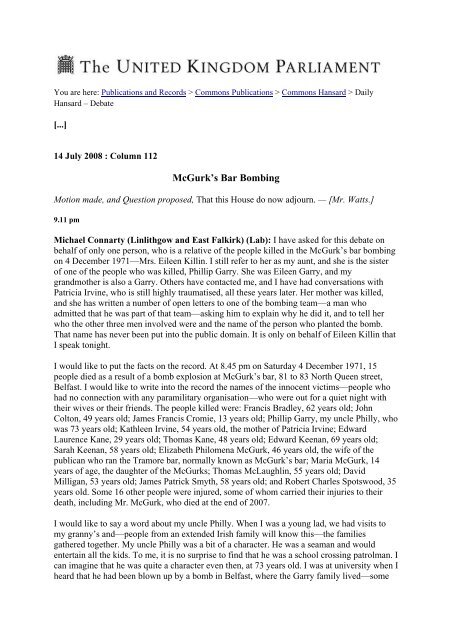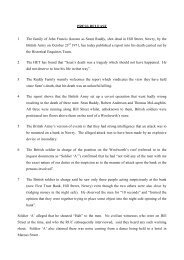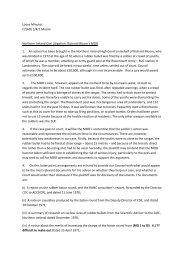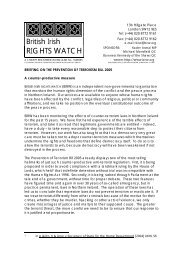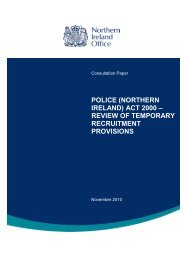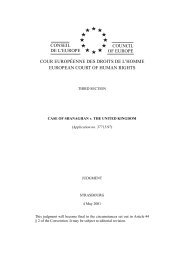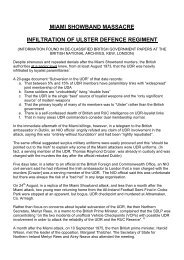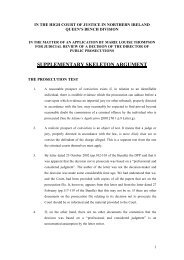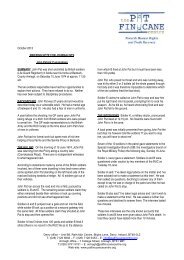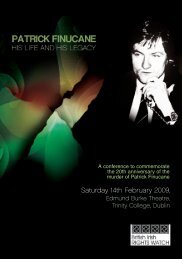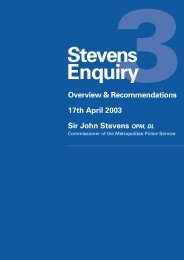McGurk's Bar Bombing - The Pat Finucane Centre
McGurk's Bar Bombing - The Pat Finucane Centre
McGurk's Bar Bombing - The Pat Finucane Centre
You also want an ePaper? Increase the reach of your titles
YUMPU automatically turns print PDFs into web optimized ePapers that Google loves.
You are here: Publications and Records > Commons Publications > Commons Hansard > Daily<br />
Hansard – Debate<br />
[...]<br />
14 July 2008 : Column 112<br />
McGurk’s <strong>Bar</strong> <strong>Bombing</strong><br />
Motion made, and Question proposed, That this House do now adjourn. — [Mr. Watts.]<br />
9.11 pm<br />
Michael Connarty (Linlithgow and East Falkirk) (Lab): I have asked for this debate on<br />
behalf of only one person, who is a relative of the people killed in the McGurk’s bar bombing<br />
on 4 December 1971—Mrs. Eileen Killin. I still refer to her as my aunt, and she is the sister<br />
of one of the people who was killed, Phillip Garry. She was Eileen Garry, and my<br />
grandmother is also a Garry. Others have contacted me, and I have had conversations with<br />
<strong>Pat</strong>ricia Irvine, who is still highly traumatised, all these years later. Her mother was killed,<br />
and she has written a number of open letters to one of the bombing team—a man who<br />
admitted that he was part of that team—asking him to explain why he did it, and to tell her<br />
who the other three men involved were and the name of the person who planted the bomb.<br />
That name has never been put into the public domain. It is only on behalf of Eileen Killin that<br />
I speak tonight.<br />
I would like to put the facts on the record. At 8.45 pm on Saturday 4 December 1971, 15<br />
people died as a result of a bomb explosion at McGurk’s bar, 81 to 83 North Queen street,<br />
Belfast. I would like to write into the record the names of the innocent victims—people who<br />
had no connection with any paramilitary organisation—who were out for a quiet night with<br />
their wives or their friends. <strong>The</strong> people killed were: Francis Bradley, 62 years old; John<br />
Colton, 49 years old; James Francis Cromie, 13 years old; Phillip Garry, my uncle Philly, who<br />
was 73 years old; Kathleen Irvine, 54 years old, the mother of <strong>Pat</strong>ricia Irvine; Edward<br />
Laurence Kane, 29 years old; Thomas Kane, 48 years old; Edward Keenan, 69 years old;<br />
Sarah Keenan, 58 years old; Elizabeth Philomena McGurk, 46 years old, the wife of the<br />
publican who ran the Tramore bar, normally known as McGurk’s bar; Maria McGurk, 14<br />
years of age, the daughter of the McGurks; Thomas McLaughlin, 55 years old; David<br />
Milligan, 53 years old; James <strong>Pat</strong>rick Smyth, 58 years old; and Robert Charles Spotswood, 35<br />
years old. Some 16 other people were injured, some of whom carried their injuries to their<br />
death, including Mr. McGurk, who died at the end of 2007.<br />
I would like to say a word about my uncle Philly. When I was a young lad, we had visits to<br />
my granny’s and—people from an extended Irish family will know this—the families<br />
gathered together. My uncle Philly was a bit of a character. He was a seaman and would<br />
entertain all the kids. To me, it is no surprise to find that he was a school crossing patrolman. I<br />
can imagine that he was quite a character even then, at 73 years old. I was at university when I<br />
heard that he had been blown up by a bomb in Belfast, where the Garry family lived—some
of our family had moved to the north and some had come over to work in the steel mills of<br />
Lanarkshire, including the husband of my grandmother, Michael Plunkett.<br />
Uncle Philly was the kind of character who left a memory, as a happy-go-lucky kind of guy.<br />
But there he was, out for his pint on that night with his friends and people out with their<br />
family, when what we now know to have happened took place. An Ulster Volunteer Force<br />
team, of which Robert Campbell was a member,<br />
14 July 2008 : Column 113<br />
was sent from a pub in west Belfast with the orders to blow up not McGurk’s bar—that is the<br />
point—but the Gem bar in the same street. <strong>The</strong> Gem bar was an IRA pub and was known as<br />
one—it was where members of the IRA gathered. When the members of that UVF team got<br />
there, they were cowards. <strong>The</strong>y did not try to plant the bomb in a pub that was run by the IRA,<br />
so they went to the nearest Catholic pub and bombed innocent people out for a quiet drink.<br />
I see my hon. Friend the Member for Morecambe and Lunesdale (Geraldine Smith), who used<br />
to live in the area. She knew the pub and, she has told me, knew the family.<br />
Geraldine Smith (Morecambe and Lunesdale) (Lab): It really is a small world. When I<br />
was very young I went to the local school, St. <strong>Pat</strong>rick’s, and knew my hon. Friend’s uncle<br />
Philly, the school patrolman who used to lead me across the road. My father knew him too,<br />
because they used to go to sea together before my hon. Friend’s uncle was a patrolman. <strong>The</strong><br />
McGurks were a very decent and religious family, and everyone was filled with great sadness<br />
when that explosion happened.<br />
Michael Connarty: That was the point—McGurk’s bar was not a pub that was involved in<br />
the troubles. <strong>The</strong> bombing happened in ’71. <strong>The</strong> troubles were bubbling up and there had been<br />
a few bombings in the Province, but the attack saw the largest loss of life in one bombing at<br />
that time.<br />
As far as I am concerned, the perpetrators—Robert Campbell and his friends, the UVF hit<br />
men—were cowards. <strong>The</strong>y did not try to bomb the pub that they were sent to, but, according<br />
to the evidence that he gave after his trial, they were told, “Don’t come back until the job is<br />
done.” <strong>The</strong> job was never done. <strong>The</strong> members of that team never bombed the Gem bar. <strong>The</strong>y<br />
bombed a pub full of innocent people, putting the bomb inside a porch, which, as it happens,<br />
blew the walls out and roof off, killing the two children playing upstairs and 13 people in the<br />
public bar downstairs.<br />
Let me turn to the role of the Army. I am not involved with any side in this business—<br />
accusations of collusion have flown around, given the fact that no Army patrols were around,<br />
and people have asked how that car got to that location in that area without being stopped, and<br />
so on. <strong>The</strong> car was never found when it was abandoned, which is interesting. However, I do<br />
not care about that. What I care about is the documents in the report, including the situation<br />
reports, which were secret until 30 years thereafter. <strong>The</strong> <strong>Pat</strong> <strong>Finucane</strong> centre submitted those<br />
reports, having found them, to the historical inquiries team. It is clear from the reports that<br />
there was a travesty involving the Army, which said in the report that the bomb was clearly<br />
inside the pub, because five men standing around it were blown to smithereens. <strong>The</strong> Army<br />
said that the bombing was clearly an IRA own goal—it said that the bomb was, in effect, in<br />
the pub in transit. That was then. <strong>The</strong> historical inquiries team report says that it was
ecommended that the Secretary of State answer a question in the House confirming that<br />
story.<br />
That was never done, but, sadly, a former Member of the House, now Lord Kilclooney, said<br />
on television and in Stormont that the bomb was an IRA bomb. He said that there was no<br />
question that the bombing was a<br />
14 July 2008 : Column 114<br />
Protestant paramilitary operation. After that, a terrible, scurrilous article appeared in <strong>The</strong><br />
Guardian, which had clearly been briefed by the Army, confirming the account in the<br />
situation report—a secret document that was never referred to as the source—and repeating<br />
the calumny that those innocent people out for a drink were an IRA team. In fact, the people<br />
who claimed responsibility—the Empire Loyalists who phoned up—said that they bombed<br />
the bar because IRA commanders and units met there, but they knew that to be a lie. Did their<br />
operating commander think that they had bombed the Gem bar, courageous soldiers that they<br />
were in the fight against the IRA? That possibly is true, because the report was that the pub<br />
that was bombed was an IRA hotbed, when it was in fact an innocent place where ordinary<br />
people gathered for a quiet night out.<br />
That calumny ran as the founded story in Ireland until 1977, when Robert Campbell was<br />
arrested. I must criticise the historical inquiry’s report for saying that he was arrested for<br />
bombing McGurk’s bar as a result of intelligence, because he was not—he was arrested<br />
because he shot a Protestant. He thought that he was going to shoot a Catholic, but he shot a<br />
Protestant; the Catholic men in the van he was targeting, who worked in a quarry, escaped. He<br />
was arrested because his own people shopped him for killing one of their own. He then asked<br />
for McGurk’s bar to be taken into account and he admitted his role, saying that what he had<br />
done had troubled him ever since. He was a young man at the time of the bombing, but when<br />
they arrested him he was a platoon commander in the UVF and had no doubt carried out a<br />
number of other crimes in between. He got 20 years, of which he served 16.<br />
Andrew Mackinlay (Thurrock) (Lab): Will my hon. Friend give way?<br />
Michael Connarty: No, I will not.<br />
For six years, the approach taken in all the police reports—this is clear from the historical<br />
inquiry team’s report of the police reports—was to keep trying to turn the evidence to suggest<br />
that the Army report was correct. <strong>The</strong> reports said things such as that the forensics showed<br />
there was no doubt that the bomb had been inside the pub. <strong>The</strong> forensic evidence did not<br />
come out until February, but Dr. Hall, who produced it, said that there was no doubt that the<br />
bomb had been placed outside the door or adjacent to it—not in the pub at all. However, the<br />
police reports still spread the same story, and every single inquiry in the report shows that the<br />
police tried to pin the bombing on the people in the bar to show that they had killed<br />
themselves and their fellow citizens from the community. That is unforgivable.<br />
Another criticism that I have of the historical inquiry’s report is that page 9, which discusses<br />
the killing of an Army major following the bombing, should not have been included, because<br />
it is not relevant. It is as if people are still trying to do the same thing—to say that these<br />
innocent people were somehow caught up in what happened afterwards, but they had nothing<br />
do with it. My uncle Philly and his colleagues and friends had nothing to do with the IRA and<br />
other such organisations. If it was not for the <strong>Pat</strong> <strong>Finucane</strong> centre, I am not sure whether the
historical inquiry’s team would ever have seen the secret documents that are now in the public<br />
domain and in its report.<br />
14 July 2008 : Column 115<br />
Why am I raising this issue? My aunt Eileen does not want to see the report, which is why I<br />
have it. I am the named person because I have raised a question in the House. She does not<br />
want to see the report or to remember what happened; she is very old and does not want the<br />
trauma of it all, but she does want the peace of mind that goes with knowing that the House<br />
recognises that the things that we did as a nation—the way in which we spread malicious<br />
gossip about the people who were killed and tried to make it stick—were wrong.<br />
I do not know whether there can be reconciliation for people such as <strong>Pat</strong>ricia Irvine, who<br />
wants to know who the man was who got out of the car and placed the bomb. It was not<br />
Robert Campbell, but another man who was sitting outside the bar in the back seat. I know<br />
that the McLaughlin family are very upset and still accuse people of collusion, and I do not<br />
know whether they will ever have reconciliation. However, I am looking for peace and<br />
reconciliation.<br />
Mr. Campbell refuses to be interviewed or to give any evidence and says that he wants the<br />
right to see his life out in peace and quiet now that he is in his 70s. I do not believe that that<br />
man should have that right; he was a coward and he was part of a cowardly team that killed<br />
innocent people. He is living here in England, and it behoves him to tell the families who<br />
planted the bomb and who his accomplices were. I do not think that he has paid his debt to<br />
society.<br />
<strong>The</strong> Secretary of State is here and he said in answer to a question that I asked on 25 June that<br />
he personally was sorry for the things that had happened and for the distortions of the truth,<br />
but I want slightly more than that. We are clearly talking about a Government-sponsored,<br />
defence-sponsored method of operation, and books have been written about it. To suggest that<br />
these innocent people did this to themselves, their colleagues, their friends and their families<br />
is unforgivable, and the Government must be prepared to apologise publicly. I am<br />
disappointed that the Secretary of State for Northern Ireland is not replying to this debate. He<br />
may have the weight to be able to do what needs to be done. If he does not, I will be coming<br />
back to ask someone else further up the tree for an apology on behalf of the people who were<br />
killed at McGurk’s bar.<br />
9.24 pm<br />
<strong>The</strong> Minister of State, Northern Ireland Office (Paul Goggins): I congratulate my hon.<br />
Friend the Member for Linlithgow and East Falkirk (Michael Connarty) on his success in<br />
obtaining this debate. It is an important topic for him not only because of the wider public<br />
interest but also, as he explained, because a member of his family—Phillip Garry, about<br />
whom he has spoken so affectionately—was killed in the indiscriminate and callous bombing<br />
of McGurk’s bar in 1971, so I want to express at the outset my deepest sympathy to my hon.<br />
Friend and members of his wider family circle. I am also conscious that 14 other people—<br />
including a 13-year-old child, James Francis Cromie—were killed and 16 were injured. Thirty<br />
seven years on, the pain remains real for their families and friends, too. My hon. Friend spoke<br />
about the trauma that people still feel. This bombing
14 July 2008 : Column 116<br />
was, until the terrible bombing in Omagh in August 1998, the largest civilian loss of life in a<br />
single incident during the years of the troubles.<br />
We are discussing tonight one of 363 reports produced so far by Northern Ireland’s Historical<br />
Enquiries Team. Established in 2005, the HET is part of the Police Service of Northern<br />
Ireland, but it is operationally independent and staffed by a mix of people, including former<br />
detectives from outside Northern Ireland. Just last week, in its latest report, the Northern<br />
Ireland Affairs Committee expressed themselves<br />
“impressed by the personal commitment, sensitivity and professionalism of the Chief<br />
Constable, the Director of HET and the other staff involved in HET”.<br />
<strong>The</strong> HET is tasked with reviewing all 3,268 deaths that occurred as a result of the troubles<br />
between 1968 and 1998, with the twofold aim of striving to bring a measure of resolution to<br />
families and ensuring that all investigative and evidential opportunities are subject to<br />
thorough and exhaustive examination. Its approach is family centred and in its review of the<br />
McGurk’s bar bombing, the HET has attempted to answer more than 50 questions from<br />
family members. To carry out this work effectively, the HET has developed a five-phase<br />
process that includes the collection, assessment and review of all relevant and available<br />
material followed by focused reinvestigation and resolution. In this review as in others, the<br />
HET accessed witness statements, forensic reports, the original police case papers and<br />
intelligence information.<br />
Every one of the deaths that occurred during the troubles is a tragedy, but each case is also<br />
unique and families will have different views and perspectives and different questions and<br />
issues of concern. Following the McGurk’s bar bombing, the hurt and grief felt by all those<br />
directly affected and, indeed, by the wider community was intensified by the inaccurate<br />
commentary and reporting that it was the result of a so-called IRA “own goal”.<br />
In summary, the HET reached the following conclusions. <strong>The</strong> bomb was located inside<br />
McGurk’s bar within a small, enclosed entrance area off Great George’s street, but outside the<br />
public bar area where the victims and survivors were mainly located. <strong>The</strong> original target, as<br />
my hon. Friend mentioned, was probably the Gem bar rather than McGurk’s.<br />
<strong>The</strong> Ulster Volunteer Force was responsible for the bombing and in 1978 Robert James<br />
Campbell pleaded guilty to 15 counts of murder and was given a life sentence. <strong>The</strong> HET<br />
found no evidence of collusion by the police or security services with the UVF and confirmed<br />
that the Royal Ulster Constabulary allocated substantial resources to the original investigation<br />
in 1971. Its assessment, however, was that those carrying out the investigation may have<br />
attributed more significance to the potential involvement of republican paramilitaries than the<br />
balance of evidence supported.<br />
<strong>The</strong> HET's report also documents in some detail the media reports of the bombing. It includes<br />
the transcript of an interview with an eight-year-old boy, Joseph McClory, who gave a very<br />
clear account of how he saw a man place the bomb in the porch of the pub. Even so, there was<br />
speculation that one or more of those inside the pub might have been responsible. As my hon.<br />
Friend said, the HET report includes a copy of a Ministry of Defence document stating—this<br />
is a direct quotation from the document—
14 July 2008 : Column 117<br />
“the forensic evidence now available shows quite clearly that five of the victims were<br />
killed by blast—indicating that the explosion must have been inside the bar, and<br />
raising a very strong presumption that it was caused by the accidental detonation of a<br />
bomb being carried by one of the customers—as has seemed likely all along”.<br />
On 7 December—the Tuesday following the explosions—speaking in a debate at Stormont,<br />
the then Minister of State for Home Affairs, John Taylor, now Lord Kilclooney, said<br />
“the evidence of the forensic experts supports the theory that the explosion took place<br />
within the confines of the walls of the building.”<br />
He said that the Provisional IRA<br />
“is in retreat and nothing could aid it better at this time if it could inflame Catholic<br />
opinion as a result of what occurred at the weekend.”<br />
He called on Roman Catholics<br />
“to think twice before they accept the type of propaganda that is being fed to them<br />
about this incident.”<br />
When it came in February 1972, the conclusion of the forensic scientist Dr. Robert Alan Hall<br />
was rather different. He concluded that the combined findings, including the pathology<br />
reports, did not support the theory that a bomb had exploded close to a group of people within<br />
the confines of the bar area, and that the explosion had in fact<br />
“occurred at or about the entrance door from the porch leading off Great George's<br />
Street”.<br />
His conclusion supported the evidence of eight-year-old Joseph McClory rather than that of<br />
the Minister.<br />
Although we cannot speak for the Ministers who made statements at the time, my right hon.<br />
Friend the Secretary of State and I are deeply sorry not just for the appalling suffering and<br />
loss of life that occurred at McGurk’s bar, but for the extraordinary additional pain caused to<br />
both the immediate families and the wider community by the erroneous suggestions made in<br />
the immediate aftermath of the explosion about who was responsible. Such perceptions and<br />
preconceived ideas should never have been allowed to cloud the actual evidence. My right<br />
hon. Friend said at the weekend that<br />
“one of the things politicians have to get much better at is actually taking on their<br />
responsibility and saying, I'm sorry”.<br />
I hope that that offers some consolation to my hon. Friend and the others who have asked for<br />
an apology.<br />
I can tell my hon. Friend—in addition to what I have said about the work of the HET—that<br />
the police ombudsman carries responsibility for investigations when a death has been caused
y the actions of a police officer, or when there is information that suggests that a police<br />
officer may have acted wrongly. Such cases are referred by the HET, and currently total 64.<br />
<strong>The</strong> police ombudsman also investigates cases in which a family, or a representative of a<br />
family, makes a complaint about the handling of a case by the police. <strong>The</strong> ombudsman is<br />
currently investigating 57 such cases, and I am aware that one relates directly to the<br />
McGurk’s bar bombing. Although the ombudsman’s work and reports are completely<br />
independent of the Government, I am informed that a report is expected shortly.<br />
Northern Ireland has moved a long way since the dark days of the troubles. <strong>The</strong> UVF, which<br />
was responsible for the McGurk’s pub bombing, has put its arms beyond reach—on the way, I<br />
hope, to full decommissioning. As<br />
14 July 2008 : Column 118<br />
the Independent Monitoring Commission has indicated, the Provisional IRA is now firmly<br />
committed to the political path, and Sinn Fein is an active partner in policing and in<br />
Government. Devolution last May put schools, hospitals and other public services under local<br />
control, and I hope that it will soon be possible to hand back policing and justice powers. This<br />
week’s announcement by Bombardier about its new investment is a further sign of Northern<br />
Ireland's growing prosperity, building on long-term political stability.<br />
However, the murders and conflict that scarred Northern Ireland for 40 years still leave their<br />
mark, which is why the work of the Consultative Group on the Past is so important. Trying to<br />
find a way of addressing the legacy of Northern Ireland’s violent past in a way that does not<br />
overshadow the future remains one of the greatest challenges. <strong>The</strong> group’s task is to consult<br />
widely to see if there is a consensus on how to proceed. Over the past year the group has met<br />
with more than 100 organisations, received 245 written submissions and held seven wellattended<br />
public meetings. During this process, it heard a wide range of opinions and<br />
experiences about the past and what it means for the present. <strong>The</strong> consultation period closed<br />
in January and the group is now reflecting on what it has heard. As part of its reflections, the<br />
group has considered the various mechanisms that are currently in place to deal with the past<br />
such as the Police Ombudsman, the public inquiries and the work of the HET. Indeed, during<br />
this consultation the group met the HET and some of the many families who have been<br />
through the HET process. <strong>The</strong> thoughts that these families have on this process, and all the<br />
other mechanisms in place, will be considered in its final report. My right hon. Friend the<br />
Secretary of State and I are looking forward to receiving that report later in the year. While it<br />
is too soon to speculate on what the recommendations will be or how they can best be taken<br />
forward, it is important that any recommendations made are workable and capable of<br />
commanding widespread public support.<br />
Lord Eames and Denis Bradley—the group’s co-chairs—delivered a speech at the end of May<br />
reflecting on some of the many issues raised during their consultation. It is helpful that they<br />
recognised publicly the differing views that exist, and that a public debate takes place on<br />
some of these very difficult issues.<br />
In addition to the work of the Consultative Group on the Past, the Northern Ireland Affairs<br />
Committee published a helpful report only last week. It contains a number of<br />
recommendations on dealing with the past, although it also acknowledges the importance of<br />
awaiting the report of the Consultative Group on the Past before making definitive decisions.
Mark Durkan (Foyle) (SDLP): I thank my hon. Friend the Minister for giving way, and I<br />
fully realise why he is addressing some of the wider issues to do with the past in terms of the<br />
broader work of the HET and the Consultative Group on the Past. Returning to the particulars<br />
of this debate and McGurk’s bar, however, there is a widespread welcome for the spirit of<br />
apology offered by the Secretary of State, but he cannot apologise for everybody else. Does<br />
the Minister agree that it would be helpful if the Minister who made the offending and grossly<br />
misleading statement in the Stormont Parliament came forward and directly apologised, and<br />
will he also<br />
14 July 2008 : Column 119<br />
take steps to ensure that the apology that has come from the Government comes directly from<br />
the Ministry of Defence as well, because the Army was clearly involved in spreading this<br />
disinformation not only through a Minister at the time, but more generally through the media?<br />
Paul Goggins: I hope that my hon. Friend appreciates that this evening I speak on behalf not<br />
only of my right hon. Friend the Secretary of State and myself, but of the Government as a<br />
whole. As for what others should say or do, that is for them. I cannot speak for them, and<br />
neither can my right hon. Friend. I can only say what I<br />
14 July 2008 : Column 120<br />
see and report what I have read, and that is on the record. We have made our position<br />
completely clear.<br />
<strong>The</strong> bombing of McGurk’s bar was an horrific attack, one of too many that occurred in<br />
Northern Ireland during the troubles. <strong>The</strong> core task of the HET is to help those families most<br />
directly affected by such tragic events to receive an explanation and have their questions<br />
answered. I hope that my hon. Friend the Member for Linlithgow and East Falkirk and all the<br />
families caught up in this case have been able to take some comfort from the extensive review<br />
that has been carried out and the firm conclusions reached.<br />
Question put and agreed to.<br />
Adjourned accordingly at twenty-one minutes to Ten o’clock.<br />
[http://www.publications.parliament.uk/pa/cm200708/cmhansrd/cm080714/debtext/80714-0018.htm<br />
http://www.publications.parliament.uk/pa/cm200708/cmhansrd/cm080714/debtext/80714-0019.htm]


